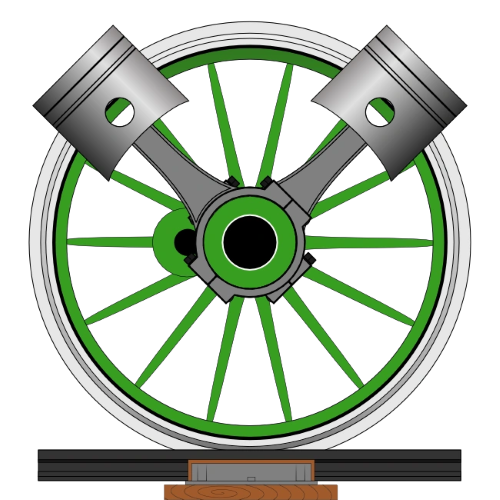The NZR Ka Class Steam Locomotives were the King's of the Central North Island Main Trunk.
Key Facts
Fuel - Waste Oil
Weight - 145.9 Tons
Wheel Arrangement - 4-8-4
Running Numbers - 930 to 964
Ka's Left
3 Ka Class Engines remain.
1 at Steam Incorporated Paekakariki
1 at Mainline Steam Auckland - Wellington - Christchurch
1 at Silver Stream Railway Hut Valley
Info
The KA class was solely based in the North Island, and upon entering service, the first members were placed on heavy freight and express passenger service. They saw extensive use on these tasks during wartime. The shrouding, while cleaning up the appearance of the locomotives, was open at the top and began gathering soot and dust that affected the working environment in the cab. After the war, a coal shortage also occurred and NZR decided to convert a large number of locomotives to oil burning. The KA class were a prime candidate due to the large size of the grate. Conversion to oil burning occurred from 1947 and 1953, with nineteen of the class done at Otahuhu Workshops and sixteen at Hutt. The conversion coincided with the removal of the shrouding, and also the replacement of the ACFI feedwater system with an exhaust steam injector.
The locomotives became a mainstay of the North Island motive power fleet, and primarily seen on the North Island Main Trunk Railway,operating the overnight Express and Night Limited from 1940. When the North Island JA entered service in 1952 they took over the Express and Limited on the Taumaranui - Auckland section, but the KA continued to be used on the Paekakariki- Taumaranui section of the Limited and Express, until displaced by DA diesels in 1963 and 1965. However on the last day of the steam power on the Limited, in April 1963 and the Express in February 1965 KAs, worked the train right through to Auckland.[1] In reality rail freight on the NIMT was almost entirely dieselised in 1955-56, but the KA and JA could pull heavier passenger and mail loads. The KA originally conceived as a mountain engine was effective on the steep section from Taihape to Taumaranui through the King Country and move ,14 car passenger trains faster than a DA. The last two KA completed in 1950 used the Baker valve gear fitted to the last US rail steam express engines of NYC and Norfolk and Western. The KA 958 and KA 959 were regulars on the Limited in the 1950s and early 1960s out of Paekakariki to Taihape.The Baker valve gear made them more free running but was intended for specialised passenger service and less effective than the earlier KA on heavy freight. The KA also worked other lines, such as the Palmerston North - Gisborne Line as far as Napier and the Stratford - Okahukura Line.The KA usually pulled the Rotorua express between Hamilton and Rotorua till it was replaced by railcars in 1959 and were used on relief expresses to New Plymouth and Napier until 1965. In the last period of KA use between 1959-1967 their freight use was mainly as bankers in the King Country and the banks on the Wanganui and Rotorua lines and mixed trains in the King Country. They remained important passenger power units because of their superior performance in the Central North Island and the fact until 1958-59 and the introduction of real air competiton with turbo prop Friendships and Viscounts [2] the overnight Express, Limited and summer Daylight limited, were the main public transport between Wellington and Auckland. The Daylight offered a 13.45 hour service over then 425 miles (cf 14.15 hrs Limited [3] or 16hr Express Mail train ) in steam days and sometimes ran the J10 Daylight as fast as 13.32 hrs, with running time of only 11.21 hrs and sustained speeds of 68/69 mph in the Shannon-Linton area.[4] The southern section of the NIMT from Otaki to Marton junction is almost as easy graded and fast as most of the SIMT, JA racetrack. However the North Island JA were the usual power for the Daylight on the Taumaranui- Auckland section and while often at a mile a minute the Northern section of the NIMT did not offer the possibility for running faster than 60 mph. The KA however burned more fuels and had higher repair and breakage rates than the JA.
At one stage, KA 944 was sent to the South Island for an overhaul at Hillside Workshops and for subsequent use on the Midland Line along with the KB class. Although it was overhauled, it did not operate on the Midland Line due to union objections and was repatriated back to the North Island.
Withdrawl
One member of the class, KA 949, was wrecked in the Tangiwai disaster on 24 December 1953, New Zealand's worst rail disaster. Although recovered from the Whangaehu River and taken to Hutt Workshops, it was never repaired and officially written off in 1955. Although the locomotive was subsequently scrapped, the NZR recovered quite a number of components from it and re-used these on other locomotives as the need arose.
With the commencement of main line dieselisation in 1954, the class was slowly displaced from front line service, especially as the DA class was progressively introduced to service from 1955. Withdrawals began in 1964. The last locomotive in revenue service, KA 935, ran in 1967. KA 942 was held for a time at Hutt Workshops for possible use as a stationery boiler, but this did not proceed.


